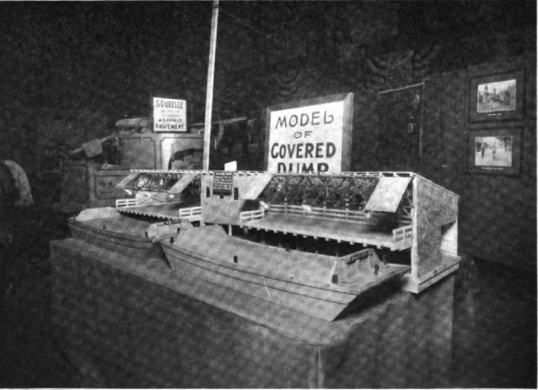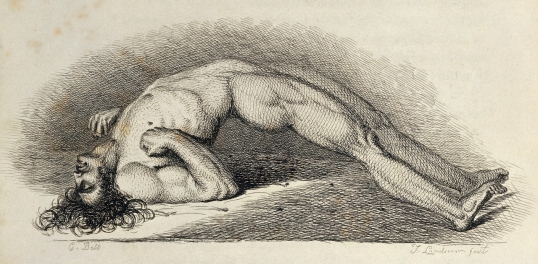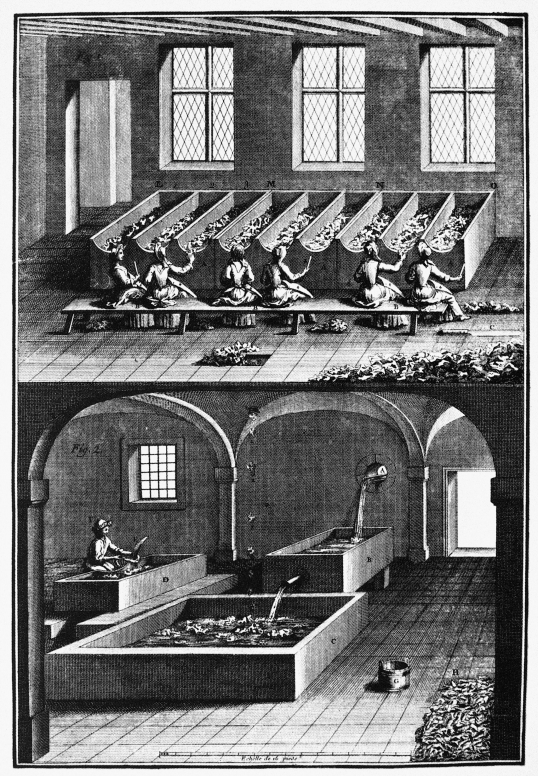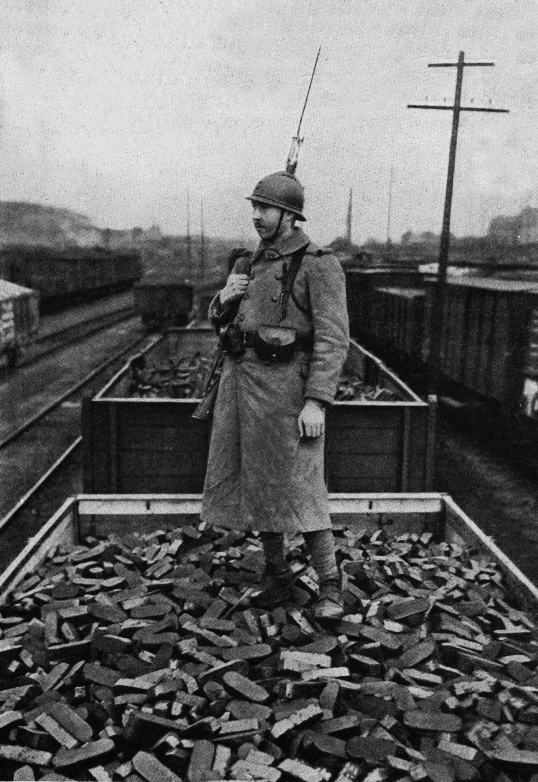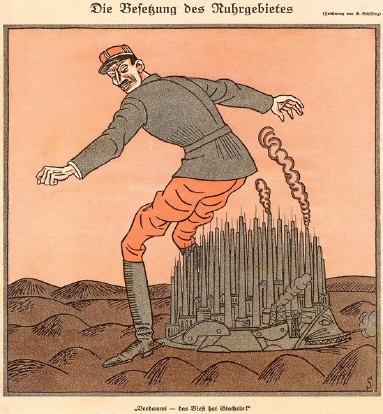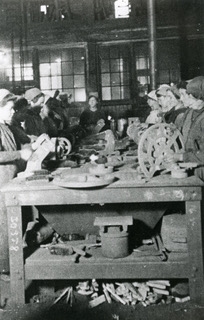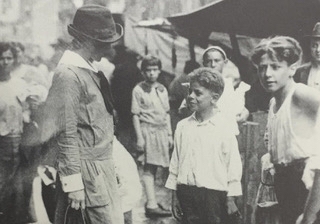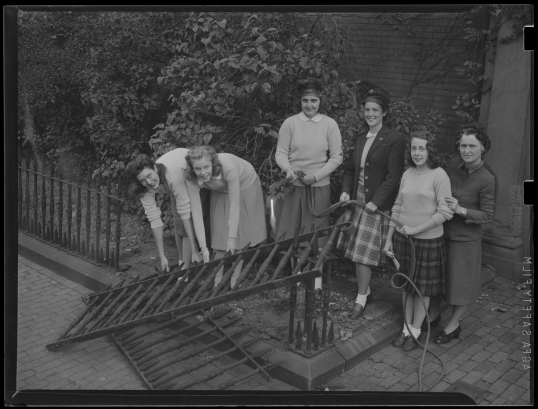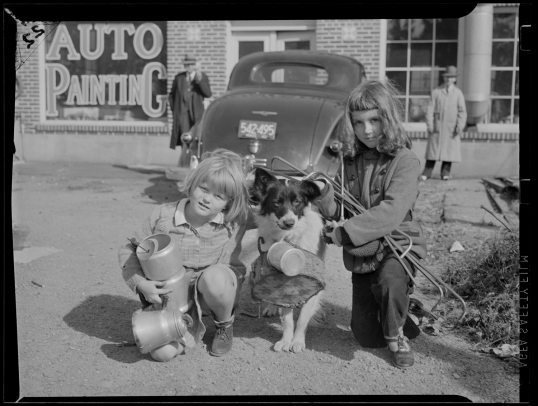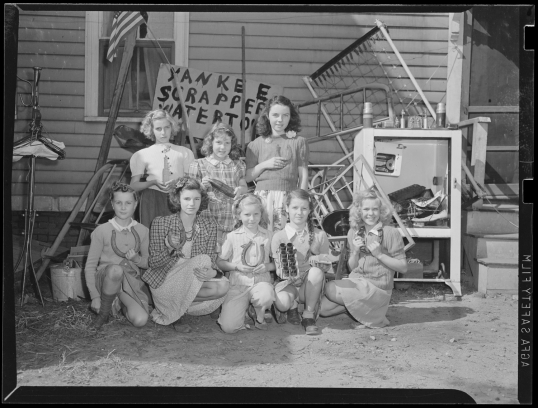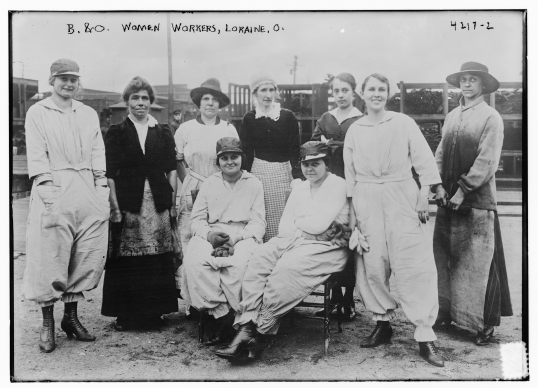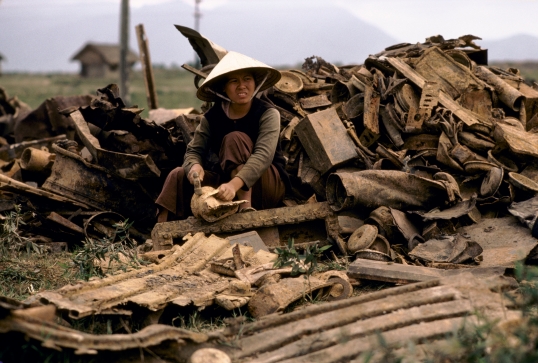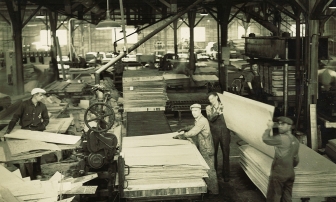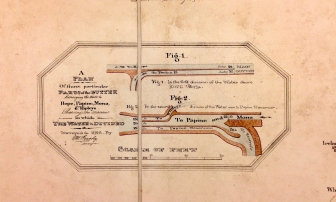Women in the Scrap Heap: Tetanus, Scrap Metals, and Women’s Labor in the Era of the World Wars
The Meaning of American Garbage to a German Woman
“It [is] the best fly film ever made.”1 This is what the German-American urban reformer Flora Spiegelberg told a packed auditorium of planners and public health officials in Manhattan on November 25, 1914. The film Spiegelberg was referring to was a “remarkable motion picture which depicted in a startlingly graphic manner the breeding and multiplication of flies and maggots in exposed garbage” on the streets of New York City.2 Spiegelberg was showing the film and delivering the opening lecture of a “Woman’s Session” as part of a lecture program associated with an exhibition on new street cleaning appliances. Spiegelberg’s shocking insect film was intended to promote a practice of garbage sorting that mixed both ash and regular refuse, a combination that, she noted, prevented the breeding of flies and maggots (fig. 1). Spiegelberg contended that “the lye and potash in the ashes would preserve the garbage and prevent it from breeding any kind of vermin, and the flies could not feed on it, nor would they be attracted to it.”3 Spiegelberg, who headed United Hebrew Charities (UHC) and had immigrated to the United States from Germany a few years prior, pointed out that the bugs and roaches she had seen littered across New York City’s streets and homes were not present in the most advanced cities in Europe, particularly Germany, and she beseeched the powerful men and women in her audience to bring New York City into a new era of sanitation.
Fig. 1. Unknown, photograph of a model of a covered garbage dump from the Exhibition of Street Cleaning Appliances, New York, NY, November 23–28, 1918.
New York Department of Street Cleaning, Report of Exhibition and Tests of Street Cleaning Appliances (New York: M. B. Brown, 1914), 12.
Spiegelberg’s polemical film and words were misguided to many in the audience. Following her talk, the city’s commissioner for street cleaning, J. T. Fetherston, portrayed Spiegelberg as an outsider trying to impose European norms on America: “She has told you how they do these things abroad. We know what they have adopted in foreign cities can be adapted to New York, but we can’t swallow things wholesale.”4
Adding to the case against Spiegelberg’s single-stream refuse proposal was Mrs. Julius Henry Cohen, who chaired the Streets Committee of the Woman’s Municipal League of New York:
We, the members of the Committee on Streets of the Woman’s Municipal League, do not agree with … Mrs. Spiegelberg … that the only way of disposing of garbage and ashes is to have a mixed collection. We think that the revenue to be gotten from the oils extracted from the garbage, together with the fertilizer to be obtained from the pulp of the garbage, and the possibility of using the ashes for filling in low land, is of greater value than the clinker which would be all that could be obtained from the incinerating of mixed garbage and ashes. Another point to be considered in comparing our city with the German cities is that in no place in the world are the people so extravagant as they are in America—in no city have they so large a quantity of garbage as in New York.5
The purpose of the special “Woman’s Session” accompanying the exhibition was to “testify to the valuable assistance” women had provided “toward educating the people up to a realization of their responsibility for the condition of the city’s streets.”6 Spiegelberg, from the written accounts, was cast as a kind of outsider, one who failed to appreciate both the magnificent scale of American garbage and the money it could occasion. In her quest to rid the city of flies and maggots, Spiegelberg also managed to insult the sensibilities of people in power. Her theatrical presentation was ostensibly a ruse for attention.
Spiegelberg was, in reality, well aware of the value of garbage and should be seen as a pioneering, transatlantic force in the realization of the full value of a certain type of refuse—scrap metal. Spiegelberg, in her emphasis on tactical scrap collecting practices led by Jewish women, provided a window into the entirely new and valuable economy of the scrap metal trade, one that would prove crucial in, among other uses, the manufacture of structural steel, the heroic skeleton of architectural modernism.
In addition to being a revisionist study on steel as a building material, this essay engages ecofeminist methodologies and work in the field of discard studies. One thing the latter does is to ask scholars not to identify how, for example, to recycle but rather why we epistemically value the act of recycling in the first place.7 I center the specific contributions of women not by showing that they too did what men did but rather by exposing what they did for the making of architectural modernism that men did not do. These “behind the scenes” women reveal the more pervasive nature of steel construction as a burden on the female body. One of those burdens has been the specter of tetanus, the third and final side of this triangulated history.
As an entry point into the question of toxicity and the risks materials pose to the human body, tetanus brings this essay’s two central subjects—women and steel—into a complex dialogue. The stakes of informal female labor come to the fore in steel production and, subsequently, in architectural construction. With tetanus we further understand the economies of risk within modern architecture’s material ecology, as unprotected and disregarded bodies and metals interact. A core question, then, is not what makes architecture toxic but what embedded inequities in the making of architecture produce new toxicities?
In the first half of the twentieth century, a period in which scrap collection experienced astonishing growth and tetanus vaccines were not yet widely available, German women (like many other women in Europe), often enlisting their children, made signal, albeit informal contributions to the metallurgical science around scrap recycling and in turn to knowledge about the structural steel upon which the built environment depended.8
Tetanus
The history of tetanus is analogous to the history of steel: known for centuries but not fully understood until the Industrial Revolution. Scottish neurophysiologist Charles Bell sent waves through the medical community in 1806 with the publication of his book Essays on the Anatomy and Philosophy of Expression.9 In it, Bell likened human as well as animal anatomy to a kind of grammar that supported the language used by design to address its human subjects.
One of Bell’s most widely reproduced sketches was that of a man in a rigid, convulsive state brought on by a tetanus infection. Bell noted that he had made the illustration from memory of numerous patients battling the brutal disease (fig. 2).10 Bell’s composite subject was of a male, likely in his twenties or thirties and of a robust, muscular build. The sketch depicted him stretched out on the ground in an arch-like form known as opisthotonos. The man’s arms and wrists contort inward, his knees and jaws lock, his toes curl, and his muscles tighten to the point that a clear map of his ligature emerges. Bell rendered the same figure as an oil on canvas three years later, indicating that he believed the image had artistic merit beyond its illustrative function (fig. 3). This physical grammar for Bell is representative of the language of the plight of tetanus: “Although there may appear to him an accidental and deranged action of the muscular frame, there is no such thing in nature. It is a disease he is representing, which has definable symptoms, and it will ever present itself with the same characters.”11 The visual difficulty of tetanus is the experience not of the patient but of the beholder. Tetanus must be read as a collection of signs, not a manifestation of conscious, embodied experience.
Fig. 2.
Charles Bell, Essays on the Anatomy and Philosophy of Expression, 2nd ed. (1806; London: John Murray, 1824), 101.
Fig. 3. Charles Bell, Opisthotonos in a Patient Suffering from Tetanus, oil on canvas, 1809.
ALAMY.
It may not simply be convention that prompted Bell to use the word men when he described those who suffer tetanus infections. The disease, which has been documented as far back as ancient Egypt, had long been associated with men due to the ailments resulting from war injuries. From arrow wounds to gunshot and shrapnel injuries, tetanus infections were often associated with men and the battlefield despite the fact that the disease had proven more fatal in children and pregnant women than it did in men.12 Treatises on and histories of tetanus infection published as recently as the 1980s, such Christian Hertle’s Historische Aspekte der Tetanustherapie und der Immunisierung gegen Tetanus bis zum Ende des Ersten Weltkrieges, continue the gendered associations from the specialist field of military medicine and deploy case studies and illustrations almost exclusively of white male patients (fig. 4).13 One could be forgiven for thinking that the tendency to depict tetanus as a white male disease serves tacitly as a valorization of it. Tetanus—unlike measles, malaria, or cholera, which are diseases typically reported in women in equal measure to men—was not a communicable disease and was free of the stigma often associated with the ill.14 These men, in other words, suffered because of their brave service defending their countries, and this sacrifice—symbolized by their infection—tethers tetanus more broadly to nationalism. Medical sexism can explain (but not justify) this historical trend to a large degree, but the lacuna also fails to account for the active roles women did play in war efforts, particularly in World Wars I and II, well prior to the mass vaccination campaigns against tetanus for women, children, and nonmilitary men that began in the late 1940s.15
Fig. 4. Appearance of tetanus in the face of a young man, as published in G. Jochmann, B. Nocht, E. Paschen, C. Hegeler, Lehrbuch der Infektionskrankheiten für Ärzte und Studierende, 2nd ed. (Berlin: Springer, 1924), 146.
Reproduced in Christian Hertle, Historische Aspekte der Tetanustherapie und der Immunisierung Gegen Tetanus bis zum Ende des Ersten Weltkrieges (Frankfurt: Peter Lang, 1984), 120.
In order to question this characterization of tetanus as a male disease born of the battlefield, we must first understand the basics of how tetanus works and why, and how its association with warfare functions to gloss over the many quotidian situations in which women (and children) were also at risk. By the time of Bell’s publication, experts understood that tetanus resulted from spores in the bacteria Clostridium tetani, an anaerobic organism that enters the body through typically deep, blood-rendering subsurface wounds.16 Once inside the bloodstream, the bacteria produce a toxin that causes painful muscle spasms and contractions, first at the site of the wound and eventually throughout the body.17 Tetanus spores are most commonly found in soil, dust, manure, and metallic rust and are more likely to infect certain types of breaches of the skin, including puncture wounds and burns. Prior to widespread vaccination efforts, tetanus posed a serious public health threat that killed between 10 and 20 percent of those infected.18
The first widely administered tetanus toxoid vaccine—made from an inactivated toxin—was introduced in 1924 and was followed by an improved adsorbed version in 1938. Mass vaccinations were provided for soldiers in World War II and then for the general population of most developed and developing nations in the early postwar period. By 1992, new vaccines that combined immunizing agents against tetanus, diphtheria, and pertussis had been rolled out.19 Tetanus has since become a manageable and rare disease resulting in relatively few deaths per annum.
Scrap Metals
The mid- to late nineteenth century was a watershed period for metal architecture. Structures like Joseph Paxton’s Crystal Palace (1851) and the early steel-framed skyscrapers of Chicago pointed architecture in a bold new direction characterized by crystalline form, unprecedented height, and vastly improved structural integrity. But the evolution of the structural steel that afforded these changes was long in the making, derived from countless sedimentary innovations, patents, and experiments in metallurgy.20 Steel and iron had been known for millennia, but it was not until the innovations of the nineteenth century that they became fully structural. One of the major sources for this progress lay in various new hearth processes for mixing molten metals that involved the addition of pieces of metal scrap to enhance the molecular rigidity of the primary ore. Countless experiments in processes slowly revealed the optimal recipes of scrap with molten iron ore. This was, of course, bright news for architects and structural engineers looking to push the boundaries of architectural form. So too was it a boon for a far less glamorous profession, one that had long been at the margins of society: scrapping. Within a short amount of time, scrappers and their finds were suddenly in high demand, and the value of scrap as a global commodity skyrocketed.21
The practice of finding and reusing salvage and scrap material is as old as civilization (fig. 5).22 In the nineteenth century the scrap trade evolved rapidly, transitioning from an informal economy that relied on itinerant scrappers, who were often plagued by tetanus infections, to a business model with a centralized repository for scrap seekers, a place known as the scrap yard. The high probability of scrap metal having sharp elements able to breach the skin, combined with the spore-friendly rust common to all metals prior to the popularization of both the galvanization process and the introduction of stainless (i.e., noncorroding) steel, is what made scrap metal a particularly common source of tetanus infection.23 There is a truism in this history: architectural modernism, reliant as it was on steel, must also be understood as a movement indebted to the unknown number of scrappers who facilitated its making and those among them who, roughly between 1870 and 1940, suffered or died from tetanus while on the job. My own estimate posits that one woman scrapper died for every kiloton of scrap sorted, which in the year 1887 in the United States, for example, would have meant roughly 270 women perishing as a result of tetanus infection from scrapping.24
Fig. 5. Women workers sorting rags dropped through an opening to the floor below and into a tank for fermentation. Unknown, copper engraving, eighteenth century.
Granger Historical Picture Archive / ALAMY.
Iron and steel structures were common enough across western Europe to constitute a minor portion of the rubble that resulted from World War I and a considerable portion from World War II. Both during and after the wars, scrap metals from destroyed structures joined a wide array of other metal items furnishing streets and homes—from banisters to radiators to cutlery—as valuable commodities. Hitherto thought of as bric-a-brac, these elements proved critical to the oxidation phase of the Bessemer, Thomas, and Siemens processes used to produce new steel war matériel in Europe, North America, and beyond. The newfangled importance of scrap metal to architecture cannot be understated: it was a crucial ingredient in facilitating all of the famous spatial guises of architectural modernism such as the open plan, the cantilever, and the curtain wall.
Germany, like most industrial nations involved in the two world wars, recognized scrap collection as a means to mobilize both people and resources at home for the war effort—the very definition of “total war.”25 The handling of domestic waste, long the responsibility of women’s “free economy” labor, as Vandana Shiva and feminist economists have described it, preempted scrap metal collecting as a distinctly female, and thus uncompensated, pursuit both during and immediately following the wars, when able-bodied men were on the fronts (fig. 6).26 Women regularized aspects of the collection, storage, and sorting of scrap under the umbrella of the so-called National Women’s Service (Nationaler Frauendienst, or NFD) from 1916 onward, the same year that the imperial government declared all household refuse to be “national property” subject to government policy.27 Scrap metals of all varieties were effectively annexed as a national resource, and unvaccinated women were their collectors and handlers.
Fig. 6. “War and the Kitchen,” an ad about industrial conservation for the Nationaler Frauendienst, 1915.
Republished in Reinhard Oberschelp and Karl-Heinz Grotjahn, Stahl und Steckrüben: Beiträge und Quellen zur Geschichte Niedersachsens im Ersten Weltkrieg (1914–1918), vol 1. (Hannover: C. W. Niemeyer, 1993), 244.
Jewish women in World War I were particularly crucial to the mobilization of the scrap metal industry, which had, well prior to the twentieth century, been dependent on the technical expertise long associated with the Jewish community, something the National Socialists would later come to see as a problem insofar as the know-how in this critical field lay nearly exclusively within the Jewish community they wanted to erase.28 Indeed, by 1938, Jewish people had been banned from the scrap trade and their businesses “aryanized.”29 Jewish women in France as well, particularly women of Romanian and Polish origin, were also crucial to the systemization of scrap there.30 Flora Spiegelberg was emblematic of both the leadership role Jewish women took in the scrap trade and of the knowledge transfer of scrap science that occurred between Europe and North America.31 Spiegelberg’s approach, as we have seen, differed in its emphasis on material economy instead of regulatory policy, hinting at a gendered difference in theoretical approaches to the early American urban reform movement. This difference was one in which the most progressive women (which did not include, for example, those of the Women’s Municipal Society) considered the relationship between the domicile and the street more holistically than did men. The problem of flies and maggots was as much one of alleyways as it was of kitchen bins. The underlying concern for Spiegelberg was twofold: the dearth of resources the urban poor endured and the unhygienic conditions of both the home and street. Germany, with its more robust social apparatus, was able to afford even the poorest neighborhoods a certain modicum of hygiene as it related to the street. This made (or perhaps inspired) a greater spatial consonance of hygiene between the private and public realms in poor areas. A two-pronged solution, Spiegelberg believed, lay in the proper handling of industrial and household refuse, a focus that earned her the name “Garbage Can Flora” and her (first and last) invitation to speak to the broad public audience she enjoyed in New York City in 1914.32 Earlier, Spiegelberg had been crucial in establishing the UHC, a women’s group that stressed the Jewish antecedents of efficient, sanitary waste management as an extension of the centuries-old Jewish tradition of a thorough sorting and cleaning of the house in the week running up to Passover festivities.33 Spiegelberg spoke frequently under the auspices of the UHC on how the domestic work of Jewish women, with their emphasis on hygiene and purity, made them particularly adept interlocutors for addressing the perils of a lack of hygiene in the public sphere, which included the perils associated with handling domestic and industrial waste.34
While Spiegelberg was tirelessly promoting all manner of urban hygiene, across the Atlantic her native Germany was regularly defaulting on the ₤6.6 billion reparation payments to the Allied powers, especially France, mandated by the Treaty of Versailles.35 The engines for the Reich’s wealth—iron and steel factories in the Ruhr valley in Germany’s west—lay in ruins. Devoid of valuable finished goods, Germany, desperate to monetize the raw materials it still had, pledged to repay as much as it could with raw materials like timber, iron ore, and, yes, scrap metal (figs. 7–8). Yet the payments still regularly fell short of what was owed, and so France, along with Belgium, entered the Ruhr in January 1923 and forced the Weimar government to surrender even more materials to keep up with reparations payments, not leaving until 1925.36 This transformed scrap yards from marginal places of informal economies into places of essential geopolitical exchange, and German women, who had been at the helm of the wartime scrap trade, had garnered a kind of informal, embodied expertise in the science of scrap.37 The Ruhr valley, Germany’s industrial backbone and the territory of industrial powerhouses like Krupp and Thyssen, was consequently expected to shoulder an outsized economic burden for the entire Weimar Republic, funneling a vast majority of its coal, iron ore, and scrap metal directly to France for its own postwar reconstruction. Women were urgently needed to assist the government in determining what scrap was usable and valuable. They were best equipped to understand the logistics of its collection and transport. All the while, in this period of intensive scrap collection, they were also unprotected from the perils of tetanus.
Fig. 7. French sentry in Germany standing watch over a load of coal briquettes after World War I, 1920.
ALAMY.
Fig. 8.
F. Schilling, “Die Besetzung des Ruhrgebietes,” Berliner Zeitung, March 3, 1921.
Although scrap metal building materials—many of which are described elsewhere in this project—comprised only a small proportion of the reparations payments, German scrap, often emblazoned with the logos of its famous manufacturers, was soon to be found throughout France, particularly in Alsace and Lorraine, where it was remelted for new materials to power the rebuilding of France or recycled and reintegrated into buildings being repaired after sustaining wartime damage.38 According to figures published by the Union of Scrap Iron Users in West Germany, an organization that was amalgamated with other important scrap traders’ associations for better control of the market, purchases of scrap iron for the two-month period subsequent to the French and Belgian occupation averaged 10,250 metric tons weekly (a number that would translate into a rate of roughly 500 fatalities of German women scrappers per year).39 German scrap-yard owners complained that their reserves of scrap iron were almost entirely depleted, and during the first quarter of 1923, manufacturers imported 124,800 metric tons of scrap from—in order of volume—France, the Netherlands, Belgium, and Great Britain (translating to an estimated 124 fatalities of women scrappers in those countries) (fig. 9).40 The aggressive removal of all manner of metal scrap from Germany handicapped its ability to restart a robust industry in structural steel, further setting it back in its efforts to rebuild. On both sides of the French-German border, women in particular were recruited to work in the scrap yards, and they were set to work in sorting and processing scrap metals that were being exported or had been imported.41 Even the burgeoning environmental movement in Germany, which had taken aim at the belching smokestacks of the Ruhr valley’s steel companies, would not have imagined that a toxic—or at least perilous—form of pollution in the area consisted of the enormous multitudes of tetanus spores lying invisibly in its scrap heaps.42
Fig. 9. Unknown, French women working with scrap metal during the Great War, 1917.
ELMAG-SACM.
Spiegelberg’s fundamental contribution to the scrap trade was in her urging women to view the street as a seamless extension of domestic space and, in turn, to think of material waste through the lens of good housekeeping, thriftiness, and cleanliness. “The city clean—sanitary, dustless, odorless and flyless—should be the slogan of women,” she said in 1912.43 Indeed, by the time of the US entry into World War I, the collection of metal scrap had, as it would in Europe, taken on a new meaning that pointed to Spiegelberg’s prescient urban philosophy. Women in possession of domestic metal scrap—broken appliances, tin cans, roofing, and other metal bric-a-brac—could place a telephone call to the UHC central office, which would in turn dispatch a collector (often a single woman in need of work) to collect the scrap and bring it back to headquarters (fig. 10). There, with no sanction or endorsement from the male officials who had spurned her in 1914, Spiegelberg supervised a team of women who would evaluate the junk and repair it or sell it off to steel manufacturers in New Jersey for reincarnation as high-grade steel in American plants employing the Bessemer process.44
Fig. 10. A social worker, possibly Flora Spiegelberg, conducting work for the United Hebrew Charities in Manhattan’s Lower East Side.
Courtesy The Jewish Board.
During both world wars, citizens of nations at war were encouraged to contribute to the war effort by rationing things like bread and oil and contributing reusable materials such as metals to newly established local scrap yards, where household appliances, grates, banisters, screens, gates, fences, cans, and other metallic items were collected, sorted, and shipped off to be recycled into new incarnations useful to the war effort: guns, tanks, shells, and so forth. This effort was associated even more with World War II, when scrap drives became known popularly as “industrial conservation,” a distinct form of patriotism also associated with women. It is important, however, to distinguish these efforts from those of Spiegelberg’s. Industrial conservation had a 1:1 relationship with nationalism, something Spiegelberg’s domestically and religiously informed practices did not. Hers was a philosophical effort; industrial conservation was a military-industrial one. In other words, Spiegelberg’s oikos was one markedly different from the paternalistic notion of it we have to come to associate with a sovereign figure; it is a lived-in oikos, one that contends with material conditions in the domestic realm, the district, and the city.45 Other women, however, including upper-class women, saw scrapping as part of their duty to the state, one accompanied by the reproductive work involved with creating sons for the war front. One oikos is ecofeminist, the other atavistic.
Images from the great scrap drives of 1942 in the Boston area testify to the uncomplicated mood of the latter. They show young women and girls engaged in scrap sorting, dismantling, and welding (figs. 11–13). These women and girls, standing with their finds and exhibiting a palpable sense of pride, demonstrate the transposition of oikos into a public sphere (photographer Leslie Jones captured their images in the street with their scrap) and highlight the nature of this effort as one that proudly showcased its feminine character. But the press that covered drives like these tended to gloss over the essential role of women and girls. The Boy Scouts of America joined in on the obfuscation, touting the scrap drives as one big national “treasure hunt” for boys and men, lending the essentially military operation the glossy veneer of a big, national game.46 The magazine Boys’ Life issued what was perhaps the most patriarchal account of the scrap efforts, running in practically comical contradistinction to Jones’s woman-centric photographic evidence: “Boy Scouts can make a personal canvass of the individual homes by explaining the situation to housewives and, if desired, help them make the survey.”47 Adult women, we are to believe, needed to be informed of the mechanics of the scrap trade by their prepubescent sons—that is, if these boys “desired” it.
Fig. 11. Leslie Jones, young women scrapping metal, 1942.
Courtesy of the Boston Public Library, Leslie Jones Collection.
Fig. 12. Leslie Jones, young women scrapping metal, 1942.
Courtesy of the Boston Public Library, Leslie Jones Collection.
Fig. 13. Leslie Jones, young women scrapping metal, 1942.
Courtesy of the Boston Public Library, Leslie Jones Collection.
Even when women and girls were mentioned as agents of industrial conservation, their precise contributions were often minimized. One report from the New York Times in September 1942 perpetuated the “treasure hunt” motif, telling the story of eighteen young men and women from St. Louis who had turned an outing into a scrap hunt: “The young women scout the territory where they are holding their steak fries and when they spot a piece of metal they call the men to dig it out.”48 Other reports more fully recognized the often formalized role women played as “scrap sentries.” One such sentry was Mrs. Mortimer H. Hess, who chaired the salvage efforts of the American Women’s Voluntary Services at the national level and also served as assistant director of salvage for all of New York City. In the New York Times article, Hess reveals that it was she who volunteered her group to organize national scrap efforts to the War Production Board’s director of conservation, Lessing Rosenwald, not vice versa.49
It is impossible to link these girls and women to the tetanus infections that a portion of them inevitably suffered because there is no good data, in Germany, France, or the United States, to this end. Despite the obvious (often uncompensated and very much informal) leadership roles women took in the professionalization of the risky scrap metal trade on both sides of the Atlantic, a gendered through line of the field stubbornly persisted. The American metallurgists George Henry Manlove and Charles Vickers, in their 1918 treatise on scrap, exclaimed,
Probably every boy who ever was a real boy has been engaged at some time and in some degree in assisting this industry by gathering old iron [for] the visit of the “rags and old iron” collector who traverses country road and city alley. The iron and steel thus collected brought and does bring only a tither of the price for which it sells to its consumer; but the successive steps of handling or marketing add to its price steadily. The boy gathering it from out-of-the-way places and offering a small hoard to the peddler, performs his task without knowing that no one else can do it so well because to him the value of time does not exist.50
Manlove and Vickers’s assertion that boys were only “real” if they had been involved in the scrap trade is of course both hyperbolic and chauvinistic, but more importantly it belies the gender reality that, by the first decade of the twentieth century, the scrap trade had actually become the work not only of boys but of women and girls, for whom time, it was also thought, had little currency.51 Texts like this perform a kind of facile mythologizing of male labor at a time when more women than ever before were entering the workforce, particularly poor women whose needs were less understood by larger economic theories than those of their bourgeois counterparts. As with tetanus, a gender bias was clouding reality in the popular imagination of these two different but linked arenas of activity (tetanus and scrap). Were we to read the expression of ill women as the grammar of a larger story, the way Charles Bell suggested, with the same fervor as men, we might today have a much better idea of just how pernicious the scrap trade was for the health of women. So too could we enumerate the root sacrifices these women made in their facilitation of architectural modernism and its rebuilding when war leveled it.
The reality of women’s work was dutifully publicized in certain domains, particularly trade journals on either side of the Atlantic, in which platitudes and nationalisms were less important than the facts on the ground. The journal Railway Mechanical Engineer, for example, spoke explicitly to the gendering of the scrap trade in 1917 in articles accompanied by illustrations. “Women have been found to be well adapted to sorting the smaller and lighter classes of scrap material,” the article noted, showing women scrappers, among other tradeswomen, from a Painesville, Ohio, scrap reclamation plant (fig. 14).52 The article cited the larger benefits of formally employing women scrappers: it “releases” men, in the article’s words, from the “unskilled” work of scrap sorting and in turn allows them to work on jobs requiring greater skills, in this case those related to railroad work, for which “women are not so well adapted.”53 Another advantage was that hiring women facilitated smoother transitions in industrial labor when men were conscripted for military service.54
Fig. 14. “B & O Women Workers,” railway workers and scrappers, Loraine, Ohio, May 14, 1917.
Library of Congress.
Regardless of whether or not it was known that women were shouldering the weight of the global scrap trade by the twentieth century, efforts to prevent and treat tetanus were being directed almost exclusively toward the men in the battlefields. At first glance, it is easy to understand why. German records, for example, show that by the end of the first summer of the war, in 1914, an astounding 3.8 percent of German men fighting in Belgium and France had succumbed to tetanus infections (fig. 15).55 By early October, the chief military officer for hygiene and sanitation, Otto von Schjerning, had recommended to all of the field doctors and nurses staffing German Lazarette (mobile army surgical hospitals, or MASH units) that Emil von Behring’s two-year-old experimental tetanus antitoxin serum should be administered to all injured soldiers, including those without symptoms, as a preventative measure.56 Men whose wounds had come in contact with soil or horse manure or whose wounds had been caused by a foreign body (such as a bullet) received priority. Upper-class women acted as couriers for the serum in its early wartime uses, perhaps because it was believed they were less likely to be intercepted. Mrs. C. Mitchell Depew, wife of the nephew of Chauncey Depew, a US senator from New York, clandestinely converted her chateau in Longueil into a makeshift hospital and reported smuggling a secret delivery of the serum to wounded soldiers.57 She herself never even thought to take the serum.
Fig. 15. Wounded German soldiers at the Western Front, published in Süddeutsche Zeitung.
ALAMY.
Field physicians reported that none of those who received the serum had experienced symptoms of tetanus infection.58 Von Behring passed away just months before his serum would see its first real-world application in the battlefield, but he and his lab at the University of Marburg would be celebrated as the “Savior of Soldiers” (and not, for example, as the pioneers of a vaccine for all men, women, and children). German officials ordered the Marburg labs to increase and speed up production of von Behring’s serum, which was the single most important factor in Germany’s impressive 94 percent survival rate for wounded soldiers, a significant increase from the 75 percent rate during the Crimean War, when military hospital personnel often resorted to drastic medical measures, like amputation.59 We ought to gauge this achievement against the backdrop of a hierarchical system of military medicine and rampant nationalism that gives priority to soldiers on the battlefield. We can also challenge the framework that placed women dead last on this list of priority for preventing tetanus infection.
Ecofeminism in the Scrap Yard?
The relationship between gender, warfare, and domesticity is well known: women, with men on the war front, went to work in many industrial trades that had been predominantly occupied by male laborers, and these women took their newly gained industrial skills back into the home upon the return of soldiers from war. The women shaping the scrap metal trade fit rather neatly into this story.60 It is the biopolitical and ecological aspects of the tale that warrant further reflection. Although not explicitly a movement born of concerns for the environment or the condition of women, the women-led movement of scrap recycling is very much a nexus of ecofeminist concerns: the maximization of resources, the deployment of tactical strategies for social preservation, and an attunement to the harmony of the home and its wider environmental context. In terms of biopolitics, the women-led scrap trade came to pass despite the real threat of tetanus infection from poorly handled pieces of scrap metal. Indeed, as women did not receive tetanus vaccinations in large numbers until well after World War II, three decades after many men started receiving them, it was plainly articulated that not only was men’s labor more valuable, so too were their lives.
The life cycle of iron and steel—the materials of the heroic new scaffolding of architectural modernism—from the mine to the scrap yard was herein brought full circle. The history at hand, one of scrapping and making do, is environmental and relied on the intellectual and bodily knowledge of women, especially Jewish women, some number of whom paid the price of their vocation with their lives.
This story of female labor offers the opportunity to recuperate women’s unsung role in the building industry from the proverbial scrap heap of history. In this moment, women helped to demonstrate the ecological dynamism of steel as a building material as they enhanced supplies of the material itself, all while under the pernicious threat of tetanus. Hailing scrap’s ecological function in 1918, two observers noted how the employment of scrap in the production of new steel was the ultimate act of conservation:
It reduces the drain that otherwise would be made on the mineral wealth in the ground and staves off the day when this will be exhausted. Probably in no other line of conservation is the reclamation so complete. Coal burned is lost as coal and continues to exist only as gas, ash and power. Wood is burned or rots away and cannot be reclaimed. But metals continue as metals and do not lose their identity as such, no matter how many times they are used.61
Michelle Murphy’s and Nancy Langston’s environmental histories, as well as Stacy Alaimo’s studies in science and society, have for a decade now furnished a methodological proposition across disciplines, one that architectural history is only beginning to pick up in earnest.62 It is a proposition that asks us to turn to women and understand the work of their bodily responses to their environment, not as a pathology for a given problem (such as tetanus) but rather as a first step in uncovering the blurred yet critical roles women have played in shaping the environment, whose written record is shaped by the power white men have always enjoyed. Feminist histories of architecture, including those of D. Fairchild Ruggles, Lucienne Thys-Şenocak, and Leslie Orr, similarly ask us to understand how women are critical agents even when they are not offered the mantle of designer.63 This essay has demonstrated an allegiance to the concerns and sympathies around issues of women and their agency that these scholars have modeled. But it also models an important departure from those works, not only one where a woman’s role is recuperated for its hidden agency but also one where her bodily sacrifice is treated as a debt in the ledger that modernism owes our planet and society.
Most notable, however, in this effort of bookkeeping is the work of Vandana Shiva. In her formative essay, “The Impoverishment of the Environment: Women and Children Last” (a title just as easily applicable to saving lives from tetanus infection), she reminds us of the conception of materiality underlying the masculinist framework of unfettered capitalism and nonrenewable materials. We may think with Shiva’s twenty-first-century ecofeminist framework to reevaluate what we thought we knew of the century prior:
[One is] seen as poor if they wear home-made garments of natural fibre rather than synthetics. Subsistence, as culturally perceived poverty, does not necessarily imply a low material quality of life. On the contrary, millets, for example, are nutritionally superior to processed foods, houses built with local materials rather than concrete are better adapted to the local climate and ecology. Natural fibres are generally preferable to synthetic ones – and often more affordable.64
Fig. 16. A scrapper in Vietnam. © Christopher Pillitz.
ALAMY.
The scrap trade was and is an economy indebted to the specific ecological sensibilities that European women had been forced to hone as domestic workers prior to war. The recycling of metals into new incarnations in architecture is a course, charted by women, that runs directly through the domestic sphere, through the scrap yard, and against the threat of an inimical disease (fig. 16). This was a course steered by the sensibilities of resourcefulness, frugality, and material inventiveness, and it is what makes the qualities of eminently reusable steel latent for a new conceptual framework of materiality in twenty-first-century architecture.
✓ Transparent peer-reviewed
Peter H. Christensen, “Women in the Scrap Heap: Tetanus, Scrap Metals, and Women’s Labor in the Era of the World Wars,” Aggregate 10 (June 2022), https://doi.org/10.53965/EOAO9782.
- 1
New York Department of Street Cleaning, Report of Exhibition and Tests of Street Cleaning Appliances (New York: M. B. Brown, 1914), 23.
↑ - 2
New York Department of Street Cleaning, Report of Exhibition and Tests of Street Cleaning Appliances, 23.
↑ - 3
New York Department of Street Cleaning, Report of Exhibition and Tests of Street Cleaning Appliances, 23.
↑ - 4
New York Department of Street Cleaning, Report of Exhibition and Tests of Street Cleaning Appliances, 24.
↑ - 5
New York Department of Street Cleaning, Report of Exhibition and Tests of Street Cleaning Appliances, 24.
↑ - 6
New York Department of Street Cleaning, Report of Exhibition and Tests of Street Cleaning Appliances, 23.
↑ - 7
Works in “discard studies” that have helped inform some of the intellectual framework of this essay include Tina Beigi and Michael Hennessey Picard, “Regimes of Waste (im)Perceptibility in the Life Cycle of Metal,” Transnational Legal Theory 11, no. 1–2 (2020): 197–21; Joshua Goldstein, Remains of the Everyday: A Century of Recycling in Beijing (Oakland: University of California Press, 2020); Laura Moisi, Die Politisierung des Abfalls: Elemente einer Kulturtheorie häuslicher Müllentsorgung (Berlin: de Gruyter, 2020); María Teresa Zubiaurre, Talking Trash: Cultural Uses of Waste (Nashville, TN: Vanderbilt University Press, 2019); Max Liboiron, “Discard Studies: Doing Science Differently,” Austrian Journal for Development Studies 35, no. 2–3 (2019): 197–216; Catherine Alexander and Andrew Sanchez, eds., Indeterminacy: Waste, Value, and the Imagination (New York: Berghahn Books, 2018).
↑ - 8
Literature on the centrality of women to the scrap trade continues to grow. See Lucy E. Bailey, “Waste Is Women’s Domain: A Review of a 19th Century Housekeeping Manual,” Taboo: The Journal of Culture and Education 19, no. 3 (2020): 11; Rachel Vaughn, “Compost and Menstrual Blood: Women Wastepickers of the Work of Waste Futurity,” Catalyst: Feminism, Theory, Technoscience 6, no. 1 (2020): 1–28, Josie Wittmer, “‘We live and we do this work’: Women Waste Pickers’ Experiences of Wellbeing in Ahmedabad, India,” World Development, published November 13, 2020, online at https://www.journals.elsevier.com/world-development; Isabella de Carvalho Vallin and Sylmara Lopes Francelino Gonçalves Dias, “The Double Burden of Environmental Injustice in a Female Waste Pickers Cooperative in Brazil,” Austrian Journal for Development Studies 35, no. 2–3 (2019): 116–44; Ishani Saraf, “‘We too have blackened our hands’: Work, Harm, and Legitimacy in a Delhi Scrap Market,” Anthropology of Work Review 41, no. 2 (2020): 119–28; Kathleen M. Millar, Reclaiming the Discarded: Life and Labor on Rio’s Garbage Dump (Durham, NC: Duke University Press, 2018).
↑ - 9
Originally published as Charles Bell, Essays on the Anatomy and Philosophy of Expression (London: John Murray, 1806); 2nd ed. (1824); rewritten and republished, 3rd ed., as The Anatomy and Philosophy of Expression as Connected with the Fine Arts (1844); subsequent reprint editions in 1847, 1865, 1872, 1873 (New York), 1877, and 1890. On Bell, see A. Pichot, Sir Charles Bell: Histoire de sa vie et de ses travaux (Paris, 1858; English translation, 1860); Sir Gordon Gordon-Taylor and E. W. Walls, Sir Charles Bell, His Life and Times (Edinburgh, 1958); Lady Marian Bell, Letters of Sir Charles Bell (London, 1870); S. Gamgee, “Sir Charles Bell and Sir James Simpson: A Biographical Study,” Birmingham Medical Review 4 (1875): 85–100; Sir J. McNeill, “Biographical Notice of the Late Sir Charles Bell, K. H.,” Transactions of the Royal Society of Edinburgh 15 (1843): 379–408; and L. Carmichael, “Sir Charles Bell: A Contribution to the History of Physiological Psychology,” Psychological Review 33 (1926): 188–217.
↑ - 10
Bell, Essays on the Anatomy and Philosophy of Expression (2nd ed.), 102.
↑ - 11
Bell, Essays on the Anatomy and Philosophy of Expression (2nd ed.), 102.
↑ - 12
See World Health Organization, “Maternal and Neonatal Tetanus - WHO,” September 12, 2007, published online at https://www.who.int/immunization/diseases/Maternal_and_neonatal_tetanus_Seminar.pdf?ua=1.
↑ - 13
Christian Hertle, Historische Aspekte der Tetanustherapie und der Immunisierung gegen Tetanus bis zum Ende des Ersten Weltkrieges (Frankfurt: Peter Lang, 1984). Other important works on the disease include John B. Huber, “Tetanus and the Glorious Fourth,” Scientific American 101, no. 1 (1909): 8; Ralph Spaeth, “Tetanus,” American Journal of Nursing 42, no. 7 (1942): 729–32; and William Chalian, “An Essay on the History of Lockjaw,” Bulletin of the History of Medicine 8, no. 2 (1940): 171–201.
↑ - 14
These stigmas of course came with spatial ramifications, including quarantine facilities, leper colonies, and isolation chambers and thus take on a punitive aspect that is worthy of note when assessing the gendering of disease.
↑ - 15
For the history of the vaccine campaign in a national context, see Gareth Millward, Vaccinating Britain: Mass Vaccination and the Public since the Second World War (Manchester: Manchester University Press, 2019).
↑ - 16
“Tetanus: Commonly Known as ‘Lockjaw,’” Centers for Disease Control and Prevention, accessed June 29, 2021, https://www.cdc.gov/tetanus/index.html.
↑ - 17
Contractions are particularly acute in the jaw area, where they can cause the jaw muscles to lock, making it hard to open the mouth or swallow, which can in turn limit air supply and cause brain damage. The spasms can be so strong that they lead to severe muscle tears and/or broken bones.
↑ - 18
Tetanus deaths, particularly in the developed world, are minimal today.
↑ - 19
“Tetanus: Commonly Known as ‘Lockjaw,’” Centers for Disease Control and Prevention. See also Smithsonian Institution, “Battling Tetanus,” Smithsonian, accessed June 29, 2021, https://www.si.edu/spotlight/antibody-initiative/battling-tetanus.
↑ - 20
See Peter H. Christensen, Precious Metal: German Steel, Modernity and Ecology (University Park: Penn State University Press, 2022).
↑ - 21
On the rise of the scrap trade, see Emil Künzer, Die Entwicklung der deutschen Stahlindustrie mit besonderer Berücksichtigung der Martinstahlerzeugung und der Bedeutung des Schrottes für dieselbe (Neunkirchen [Saar], Germany: Otto H. Bauer, 1913); Carl Zimring, “Dirty Work: How Hygiene and Xenophobia Marginalized the American Waste Trades, 1870–1930,” Environmental History 9, no. 1 (2004): 80–101; and Carl Zimring, Cash for Your Trash: Scrap Recycling in America (New Brunswick, NJ: Rutgers University Press, 2005).
↑ - 22
Rags, paper, and most metals have proved their value as recyclable commodities for millennia. Biblical verses refer to the conversion of unused iron plowshares into swords (Joel 3:10) and swords into plowshares (Isaiah 2:4, Micah 4:3). The practice of scrapping materials has been a veritable form of subsistence for the poor since at least the Early Modern period, with scrapper-peddlers from China to India to the Mediterranean to colonial America helping blacksmiths and other metal trades workers supplement their stocks with bits of iron, silver, copper, and gold that could be melted and reshaped. See, for example, James Dyer, Ancient Britain (London: Routledge, 1990), 116.
↑ - 23
On stainless steel, see Jessica Varner, “Matter against Time: The Chrysler Tower, Stainless Steel Patents, and Material Modernities in the 1930s” (forthcoming).
↑ - 24
It is impossible to calculate the number of tetanus cases and fatalities linked to scrap handling generally, let alone scrap handling for structural steel alone, but some basic statistics offer speculative insights. In the three-year period between 1885 and the end of 1887, the volume of scrapped iron and steel in the United States increased elevenfold, from 24,159 tons in 1885 to 271,766 tons in 1887. A present-day scrap collection professional (who, on the one hand, is working with better equipment in 2021 than in 1885 but who, on the other, is probably working fewer hours, thus creating an estimably similar volume) turns over 1 ton of scrap per year. That would mean 271,766 full-time scrappers in 1887. Work-related injuries for contemporary scrap workers hover around 35 percent. That number was certainly higher in 1885, but let us assume it was the same for the sake of a conservative estimate. That would mean 95,118 injured scrappers in 1887. Let us assume half of those injuries were punctures sufficient to cause a tetanus infection. That means 47,559 scrappers with subsurface wounds related to scrapping in 1887. Another conservative estimate would be that 1 in 5 pieces of scrap has dirt or rust carrying tetanus spores. That means that of the 47,559 scrappers with subsurface wounds about 9,512 would be infected with tetanus in 1887. With an average fatality rate of 15 percent, that would translate to 1,427 scrappers who succumbed to tetanus in 1887. Of those, a conservative estimate would be that 1 in 2 of those scrappers were women, or about 1 female scrapper dead for every 1,000 tons of scrap handled. The US tonnage statistics are located in Verein Deutscher Eisenhüttenleute, “Die Einfuhr von Eisen und Stahl in den Vereinigten Staaten,” Stahl und Eisen 7, no. 9 (1887): 672. The processing rate of scrappers is extrapolated from Harriet Arkell, “The Scrap Metal Millionaires: How Old Vacuum Cleaners, Cables, and Cars Have Made One Man and His Small Army of Scrappers a Fortune,” Daily Mail, November 12, 2013, https://www.dailymail.co.uk/news/article-2502655/Britains-thriving-scrap-metal-trade-makes-10bn-year.html. The injury rate is extrapolated from Joseph Doherty, “Industry Must Act Now to Reduce the Injury Rate of Refuse Collectors,” LetsRecycle.com, July 11, 2019, https://www.letsrecycle.com/news/industry-must-act-now-to-reduce-the-injury-rate-of-refuse-collectors/.
↑ - 25
Heike Weber, “Towards ‘Total’ Recycling: Women, Waste and Food Waste Recovery in Germany, 1914–1939,” Contemporary European History 22, no. 3 (2013): 371.
↑ - 26
Vandana Shiva, “The Impoverishment of the Environment: Women and Children Last,” in Ecofeminism, ed. Vandana Shiva and Maria Mies (New York: Zed Books, 1993), 70–90.
↑ - 27
Weber, “Towards ‘Total’ Recycling,” 371, 379, 381.
↑ - 28
Chad Denton, “‘Récupérez!’ The German Origins of French Wartime Salvage Drives, 1939–1945,” Contemporary European History 22, no. 3 (2013): 408. See also Weber, “Towards ‘Total’ Recycling,” 372.
↑ - 29
Denton, “‘Récupérez!’,” 408.
↑ - 30
Denton, “‘Récupérez!’,” 408.
↑ - 31
Jenna Weissman Joselit, “The Jewish Woman Who Invented Recycling,” Tablet, October 18, 2019, https://www.tabletmag.com/sections/community/articles/jewish-woman-who-invented-recycling.
↑ - 32
Weissman Joselit, “The Jewish Woman Who Invented Recycling.”
↑ - 33
Weissman Joselit, “The Jewish Woman Who Invented Recycling.”
↑ - 34
On recycling as part of Jewish culture, see Matthew Ponting and Dan Levene, “2 ‘Recycling Economies, When Efficient, Are by Their Nature Invisible’: A First Century Jewish Recycling Economy,” in The Archaeology and Material Culture of the Babylonian Talmud, ed. Markham J. Geller (Leiden: Brill, 2015), 39–65; Rabbi Shlomo Brady, “Ask the Rabbi: Does Jewish Law Advocate Recycling? The Writer Points Out That While Humans Have Unique Privileges, Their Responsibilities Are Greater and Include Stewardship over the Earth,” Jerusalem Post, January 15 2015, https://www.jpost.com/not-just-news/ask-the-rabbi-does-jewish-law-advocate-recycling-387883.
↑ - 35
See Leonard Gomes, German Reparations, 1919–1932: A Historical Survey (Basingstoke, UK: Palgrave Macmillan, 2010).
↑ - 36
See Rolande Depoortere, La question des réparations allemandes dans la politique étrangère de la Belgique après la première guerre mondiale, 1919–1925 (Brussels: Académie royale de Belgique, 1997); Conan Fischer, The Ruhr Crisis, 1923–1924 (New York: Oxford University Press, 2003); Stanislas Jeannesson, Poincaré, la France et la Ruhr, 1922–1924: Histoire d’une occupation (Strasbourg: Presses universitaires de Strasbourg, 1998); Gerd Krumeich and Joachim Schröder, eds., Der Schatten des Weltkriegs: Die Ruhrbesetzung 1923 (Essen: Klartext, 2004); and Elspeth Y. O’Riordan, Britain and the Ruhr Crisis (Basingstoke, UK: Palgrave Macmillan, 2001).
↑ - 37
My conception of “embodied expertise” here is informed by the work of Donna Haraway, specifically her description of the concept of “situated knowledge.” See Donna Haraway, “Situated Knowledges: The Science Question in Feminism and the Privilege of Partial Perspective,” Feminist Studies 14, no. 3 (1988): 575–99.
↑ - 38
See Hugh Clout, After the Ruins: Restoring the Countryside of Northern France after the Great War (Exeter: University of Exeter Press, 1996); and Gomes, German Reparations.
↑ - 39
G. E. Phoebus, “German Foreign Steel Trade in 1923,” Commerce Reports, July 23, 1923, 165.
↑ - 40
Phoebus, “German Foreign Steel Trade in 1923,” 165.
↑ - 41
Bertrand Risacher and Nicolas Stoskopf, “L’industrie alsacienne dans la Grande Guerre, un désastre économique,” Revue d’Alsace 139 (2013): 77–104.
↑ - 42
See Christensen, Precious Metal, chap. 2.
↑ - 43
Weissman Joselit, “Jewish Woman Who Invented Recycling.”
↑ - 44
Weissman Joselit, “Jewish Woman Who Invented Recycling.”
↑ - 45
An anonymous reviewer of this article was helpful in my formulation of this notion.
↑ - 46
James E. West, “Treasure Hunt,” Boys’ Life 32, no. 8 (1942): 2.
↑ - 47
West, “Treasure Hunt,” 2.
↑ - 48
“Turn Outings into Scrap Hunts,” New York Times, September 26, 1942, 13.
↑ - 49
“Women Urged to Act as Salvage Sentries,” New York Times, November 4, 1942, 20.
↑ - 50
George H. Manlove and Charles Vickers, Scrap Metals: A Study of Iron and Steel Old Material, Its Preparation and Markets (Cleveland, OH: Pention, 1918), 1.
↑ - 51
On how the formalization of the scrap yard made scrap itself more valuable, see Manlove and Vickers, Scrap Metals, 38.
↑ - 52
“Women Employees in the Mechanical Department,” Railway Mechanical Engineer 91, no. 6 (1917): 359.
↑ - 53
“Women Employees in the Mechanical Department,” 359.
↑ - 54
“Women Employees in the Mechanical Department,” 359.
↑ - 55
Sven Felix Kellerhof, “Die Impfung, die den Krieg veränderte,” Die Welt, July 12, 2015, https://www.welt.de/geschichte/article149716438/Die-Impfung-die-den-Krieg-veraenderte.html.
↑ - 56
Kellerhof, “Die Impfung.”
↑ - 57
“Horrors of War Seen by Mrs. Depew,” New York Times, January 24, 1915, 3.
↑ - 58
“Horrors of War Seen by Mrs. Depew,” 3.
↑ - 59
Kellerhof, “Die Impfung.”
↑ - 60
See Beatriz Colomina, Domesticity at War (Cambridge, MA: MIT Press, 2007).
↑ - 61
Manlove and Vickers, Scrap Metals, 4.
↑ - 62
Key works include Michelle Murphy, Seizing the Means of Reproduction: Entanglements of Feminism, Health, and Technoscience (Durham, NC: Duke University Press, 2012); Nancy Langston, Toxic Bodies: Hormone Disruptors and the History of DES (New Haven, CT: Yale University Press, 2010); and Stacy Alaimo, Bodily Natures: Science, Environment and the Material Self (Bloomington: Indiana University Press, 2010).
↑ - 63
See D. Fairchild Ruggles, Tree of Pearls: The Extraordinary Architectural Patronage of the 13th-Century Egyptian Slave-Queen Shajar al-Durr (Oxford: Oxford University Press, 2020); Lucienne Thys-Şenocak, Ottoman Women Builders: The Architectural Patronage of Hadice Turhan Sultan (Aldershot, UK: Ashgate, 2006); and Leslie Orr, “Chiefly Queens: Local Royal Women as Temple Patrons in the Late Chola Period,” in The Archaeology of Bhakti: Royal Bhakti, Local Bhakti, ed. Emmanuel Francis and Charlotte Schmid (Pondichéry, India: Institut Français de Pondichéry; Paris: Ecole française d’Extrême-Orient, 2016).
↑ - 64
Shiva, “Impoverishment of the Environment,” 72.
↑
